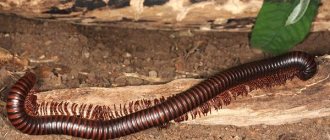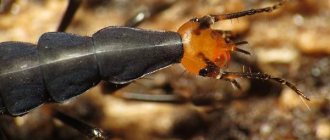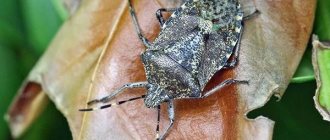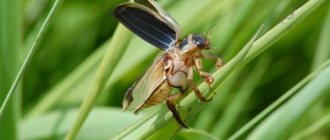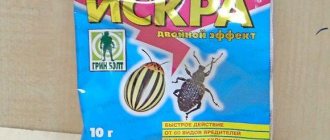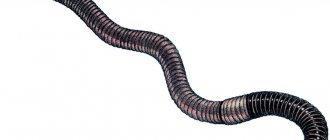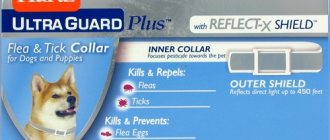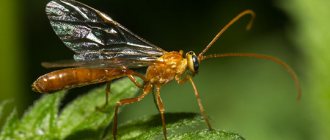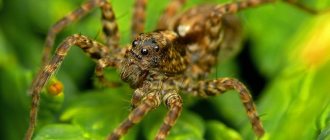The flycatcher, or popularly known as the centipede, is an insect that can often be found in residential areas in dark places where dampness is common.
Due to the repulsive appearance and rather large size of the centipede, many people experience fear and hostility when meeting it, although this is completely in vain, this type of insect does not pose any threat, and even helps get rid of flies, cockroaches, fleas and moths.
Millipedes are a large group of exclusively terrestrial arthropods, numbering about 10,500 species, most of which are found in southern latitudes and tropics.
All centipedes live in places with high air humidity (in the forest floor, under stones, in soil and rotten stumps), since they lack, with a few exceptions, a protective, waterproof, waxy layer - the epicuticle (therefore they are not protected from drying out) .
The body sizes of these animals vary from very small to large. Thus, soil Pauropoda do not exceed 2 mm in length, and giant scolopendras reach 26.5 cm, and tropical bipeds (Graphidostreptus gigas) are even larger - 28 cm.
Centipedes are characterized by the body being divided into a large number of segments. Most millipedes exhibit anamorphosis, or the formation of new segments with each molt of the animal. In primitive forms (Julidae) the number of segments is not constant.
Appearance and body structure
Due to their characteristic appearance, centipedes have long been classified as insects. However, research has shown that these groups are not homogeneous, although they have a common ancestor.
The length of centipedes varies widely: from 2 mm to 40 centimeters. In regions with a warm climate, for example, in the Crimea, you can find quite large individuals, for example, Crimean hawks, whose body size reaches 4 cm. In areas with a cool climate, small representatives of the superclass are found.
The body of centipedes is segmented. The head consists of 4 or 5 segments. The body is not divided into sections and also consists of homogeneous segments.
The main feature of centipedes, which gave rise to their name, is the number of legs: individual representatives can have up to 750 of them. Interestingly, the number of pairs of legs is never even.
The color of centipedes can be black, reddish, or ocher. The younger the individual, the lighter the shade it has.
Classification of centipedes
In accordance with the monophyly hypothesis of centipedes, the four classes are grouped as follows. The labiopods stand somewhat apart from the other three classes that form the group Progoneata.
All
Progoneata
are characterized by a number of specialized structural features (synapomorphies) that are unique to them.
For example, the genital ducts open near the anterior end of the body; During the development of the embryo, the yolk ends up not in the intestine, but in the body cavity (later, yolk-rich cells form the fat body).
Within Progoneata
The monophyletic group Collifera is clearly distinguished
,
including pauropods and bipeds.
A number of synapomorphies speak in favor of its monophyly: there are only two pairs of oral limbs (mandibles and gnathochilarium, which is a product of the fusion of the first pair of maxillae); the segment of the second pair of maxillae, unlike other centipedes, does not bear limbs and is not part of the head, forming a neck
(lat.
collum
); the genital openings are paired and are located behind the second pair of walking legs; larvae of the first instar have only three pairs of legs (one per segment); further development occurs with an increase in the number of segments that develop from the growth zone located behind the three segments of the larva.
- Progoneata:
Symphyla - Collifera:
Nutrition
All representatives of the superclass are predators. They usually eat:
- ants and their larvae;
- domestic cockroaches;
- flies, ticks.
Some species, such as the giant and ringed scolopendra, found in South America and Jamaica, are capable of hunting mice, frogs and lizards.
Centipedes use poison to paralyze and kill their victims. However, there is no need to be afraid of them: the poison produced by centipedes is harmful only to small arthropods, but not to mammals. In rare cases, the poison can provoke allergies.
Centipedes feed as follows. Having caught the victim, they inject poison into them and hold it with strong jaws and paws until the insect is completely immobilized. Only after this do they start eating.
Centipedes also destroy insects that harm agriculture. In some countries, for this reason they are under government protection.
What is a centipede and what does it look like?
The centipede looks like both a hairy spider and a worm at the same time. She quickly appears and disappears just as quickly. Those who consider the centipede to be an insect are mistaken. This is an arthropod whose body consists of 15 segments, each securely covered with a layer of quinine. Its size can reach 6 cm. The scolopendra has a threatening appearance (you can see in the photo above) due to the specific structure of its legs - each subsequent pair is longer than the previous one. The last legs have transformed into jaws, so it is difficult to immediately determine where her head is and where her tail is.
The centipede is often called a millipede. Indeed, this is one of the species of a huge superclass of arthropods, which is called “centipedes” and unites as many as 4 classes of living beings. The species of centipedes are diverse; in nature there are 12 thousand of them.
They can have very different sizes, be black, gray, green. Gray representatives of this superclass most often live in houses. This is one of the oldest groups of animals that have survived to this day. Fossil remains of millipedes date back to the Cambrian period. Scientists consider arthropods of these classes to be the first animals to colonize land.
A distinctive feature of centipedes is a large number of pairs of legs, and with age, new ones grow all the time. An adult has 15 pairs of legs. The centipede's main sensory organs are complex compound eyes and hypersensitive antennae. With them, she senses many parameters of the external environment, can feel the approach of danger and find the most comfortable place for herself.
What the common household scolopendra and other related species that live in natural conditions look like can be seen in the photo.
The body is shaggy and consists of segments with a high degree of freedom, which gives the centipede dexterity of movement and excellent reaction. Thanks to the articulated structure of the body and the special organization of the legs, scolopendra moves very quickly - up to 60 cm per second, both on horizontal and vertical surfaces.
Reproduction
Centipedes lead a solitary lifestyle. In May and June they begin their breeding season. At this time, females begin to produce pheromones that attract males.
The fertilization process of centipedes is interesting. First, the male blocks the entrance to his home in the soil and deposits a sac with sperm - a spermatophore - into the resulting shelter. After this, the female crawls under the spermatophore, capturing it with her genital appendage. A few days later she lays eggs in the hole. The female creates a layer of sticky mucus on top of the eggs, which protects the offspring from predators.
One clutch can contain from 60 to 150 eggs. The female does not leave the clutch and drives other insects away from it. To prevent mold from appearing on the eggs, the centipede secretes a special substance whose composition resembles antifungal drugs.
Centipede larvae emerge simultaneously.
How do centipedes get into apartments and houses?
A centipede living in the wild can accidentally enter a human home. However, there is a species that prefers to spend the winter in apartments and houses: the common flycatcher (below in the photo). It is called so because the basis of its diet are flies. In the warm season, it lives in fallen leaves. In winter, it is forced to seek refuge in a person’s home. Adult individuals of the species reach a length of 30-60 mm. Their body is gray-yellow, with blue or red stripes. The flycatcher's body is divided into 15 segments, each of which has a pair of legs. The first pair of legs is longer than the others: with their help, the flycatcher captures and holds prey.
The flycatcher is active both in the light and in the dark. She often sits on the walls of houses and barns, where she hunts cockroaches and crickets.
Flycatchers are not aggressive, but they can bite a person in defense. Their jaws are too weak to bite through human skin, but if they succeed (for example, a flycatcher bites a child), the sensation of its bite is reminiscent of a bee sting.
Flycatchers are considered useful because they are capable of destroying insects that cause much more harm to humans. However, due to their frightening appearance, people who notice flycatchers in their home prefer to get rid of them.
Is a centipede bite dangerous?
Drupes are a large family from the class of labiopods, in which there are about 1000 species; even experts find it difficult to name the exact number. Geophiles differ from their closest relatives by having fewer legs, and from centipedes by their small size.
Centipede drupes live everywhere. During the daytime, they hide in shelters: under fallen leaves, in a litter of moss and plant debris, in stumps, between stones - where it is damp enough. They do not burrow into deep layers of soil, but thanks to their flattened shape, the bodies can move freely in narrow tunnels.
The body color is predominantly brown, the color saturation depends on the habitat and age. The body of an adult drupe consists of 35-49 segments covered with durable chitin; individuals with 15 dorsal scutes are most often found. However, the number of walking legs does not exceed 15 pairs.
With the help of claws, near the top of which there is a duct of the poisonous gland, the lip centipede grabs prey and injects poison into it to kill it. Simple eyes are also located on the head; in some species they are numerous compound eyes. Despite the abundance of eyes, common drupes have about 40 of them, insects see poorly. The function of the organs of touch and vision is performed by the antennae.
15 pairs of legs do not prevent centipedes from moving quickly. If necessary, they show remarkable sprinting abilities and overcome up to 30-40 cm per second. Drupes can rightly be called long-livers - the life cycle is 6-7 years.
Nutritional Features
By nature, the brown centipede drupe is a predator. Feeds on small insects:
- midges;
- mosquitoes;
- small spiders;
- beetles, flies.
The peak of activity occurs at night. It can stalk its prey not only on the ground, but also from under cover.
Drupes are resistant to low temperatures. In the cold season, they successfully attack caterpillars, leaf rollers and other pests that are in suspended animation. In summer or spring, the struggle between the caterpillar and the centipede would not end in favor of the latter.
Mating and reproduction of centipedes from the drupe family is a very fascinating process. According to the observations of entomologists, the male pats his antennae, touches the female and backs away, as if inviting the “lady” to follow him. Before this, he first weaves a web and deposits spermatophores on it - small lumps of seminal fluid.
We suggest you read: How to get rid of small insects in the bathroom
In the absence of favorable conditions, the seed material is stored in the female body for several months. After fertilization, the centipede lays eggs, covers them with a special secretion to prevent drying, wraps itself around them and protects them until the young generation appears.
After 10-15 days, larvae emerge from the eggs, very similar in appearance to their parents, but with a lighter color and smaller size. Females continue to care for their babies after they are born.
Unlike adults, a newborn larva has only 7 pairs of legs. In the process of growing up, young animals undergo several molts. After each change of chitinous cover, the number of legs and dorsal scutes increases.
If you take a multi-legged insect in your hands, it begins to wriggle and twist in an arc. The drupe is not capable of biting a person, since its oral apparatus does not allow it to pierce the thick human skin.
In garden plots, centipedes are beneficial by destroying garden pests. The only people who are often dissatisfied with the appearance of drupes are flower growers. The centipede pest gets into flowerpots with untreated soil and gets into the pots when they are in the fresh air, for example, in the summer in the country house or garden. Having destroyed all the small insects in the soil, the drupe has no choice but to eat the roots and shoots of plants.
Centipedes love high humidity and dampness. The easiest way to get rid of them is to reduce watering and sprinkle the soil with wood ash. If these manipulations do not help, then it is worth moving on to more drastic measures:
- manual collection of drupes; to facilitate the process, place the pot in water for 1-2 hours and collect floating pests;
- Pieces of potatoes and carrots are laid out on the surface of the soil as bait - if the centipedes are tempted by vegetables, collect them with your hands;
- replanting the plant into new soil;
- a radical measure is treatment with insecticidal preparations, the working solution is prepared as for spraying and in accordance with the instructions, the procedure is repeated after 2 weeks.
Drupe centipedes also have their own biological enemies: birds, small mammals, reptiles, and predatory beetles.
Many people are afraid of centipedes because of their distinctive appearance. But centipedes pose virtually no danger to humans. They bite only if they sense danger (for example, when trying to catch them with their hands). However, house centipedes can crawl into clothes or shoes and sting a person while he is getting dressed or putting on his shoes. Therefore, it is recommended to get rid of centipedes only if they have settled in a house or apartment in too large numbers.
The venom of all types of centipedes is practically harmless to humans. Death from it is only possible if a person is bitten by several thousand individuals at the same time. Centipedes prefer not to bite, but to run away from humans.
The centipede's bite is quite unpleasant: it feels like a bee's. Centipedes, like wasps, bite repeatedly, injecting increasing amounts of poison. An intense burning sensation occurs at the site of the bite, the skin turns red and swells slightly. When bitten by a giant scolopendra, especially a large one, symptoms of general intoxication (fever, weakness) may occur, which persist for 2-3 days.
We suggest you familiarize yourself with: Centipede with long legs
In the photo - a scolopendra bite
California scolopendra can cause inflammation not only with a bite, but also with simple contact with the skin: when disturbed, it begins to secrete a toxic substance over the entire surface of the body.
If bitten, proceed as follows:
- Remove the stung individual from the skin as quickly as possible. In defense, the centipede continues to inject poison, which increases the unpleasant sensations;
- Apply a cold compress to the affected area. This will help reduce pain and cause capillary spasm, which will slow down the spread of poison through the bloodstream;
- if a person is prone to allergic reactions, after a bite he should take an antihistamine (for example, Suprastin or Diazolin).
A bite can cause a dangerous allergic reaction. If after a bite a person’s condition begins to worsen, breathing becomes difficult, or swelling of the subcutaneous tissue appears, an ambulance should be called. Before doctors arrive and treatment begins, you must proceed as follows:
- calm the victim, lay him on a flat surface, raising his head;
- open the windows in the room to provide fresh air, unbutton tight clothing;
- Apply a cold compress to the bite site;
- give an antihistamine.
Centipedes have a rather frightening appearance, but they are not dangerous to humans. On the contrary, representatives of all classes feed on parasitic insects, which is why they bring enormous benefits to agriculture.
Getting rid of centipedes
To get rid of centipedes, you should create the most uncomfortable living conditions for them:
- reduce indoor humidity (centipedes cannot reproduce if it is not humid enough);
- the bathroom must be regularly ventilated;
- it is important to get rid of mold;
- regularly clean baths and other damp areas using soda and products containing chlorine;
- cracks in windows and doorways must be eliminated using sealant or construction silicone;
- it is necessary to get rid of insects (crickets, cockroaches), since they form the basis of the diet of centipedes;
- If there are not very many centipedes, it is enough to catch them by hand. In this case, you must follow safety precautions by wearing thick gloves.
These methods will be ineffective if the centipedes have managed to breed in large numbers. In this case, you will have to resort to the following methods:
- boric acid: powder or solution must be applied around the perimeter of the room;
- diatomaceous earth powder: this product is safe for humans and pets, but it repels centipedes; should be scattered around the perimeter of the room;
- insecticides for controlling insects (Clean House, Raid, etc.).
Keep in mind that sticky tapes against centipedes are not effective. Only the individual’s paws will remain on the tape, which will regenerate after some time.
Harm and benefit
Centipedes cause virtually no harm. Some species, in the absence of suitable food (insects), can damage the roots of seedlings in greenhouses. However, they prefer weeds.
Centipedes bring tangible benefits to agriculture. They prey on insects (caterpillars, ticks, flies, mosquitoes), significantly reducing their numbers. They are also considered soil formers: by making passages in the soil, they improve its ventilation.
Interestingly, the poison of some species is used in folk medicine. For example, Chinese red scolopendra is used in the east to treat skin diseases. Its venom is believed to speed up the healing process.
Some people even keep and breed centipedes at home, placing them in a special terrarium.
